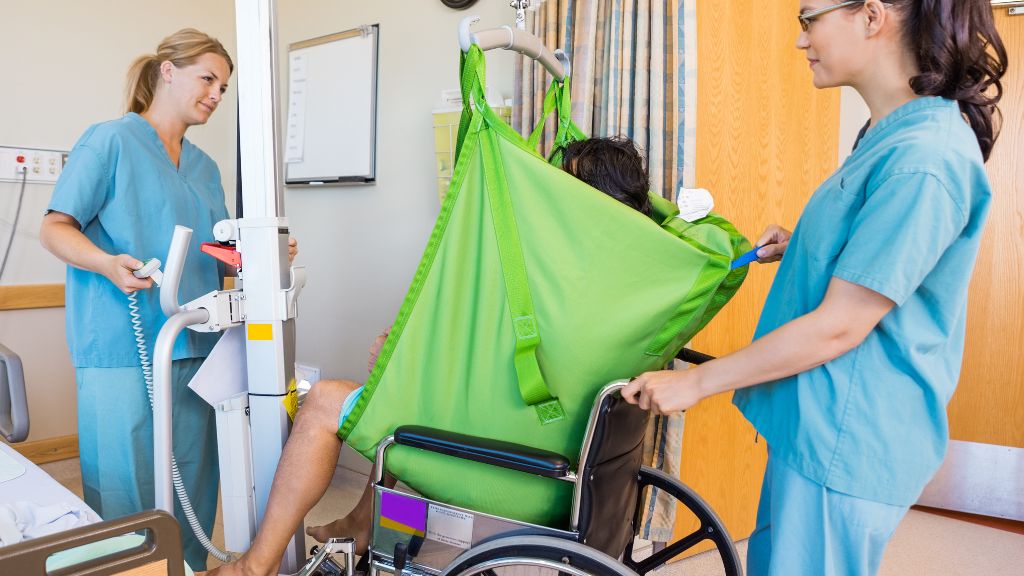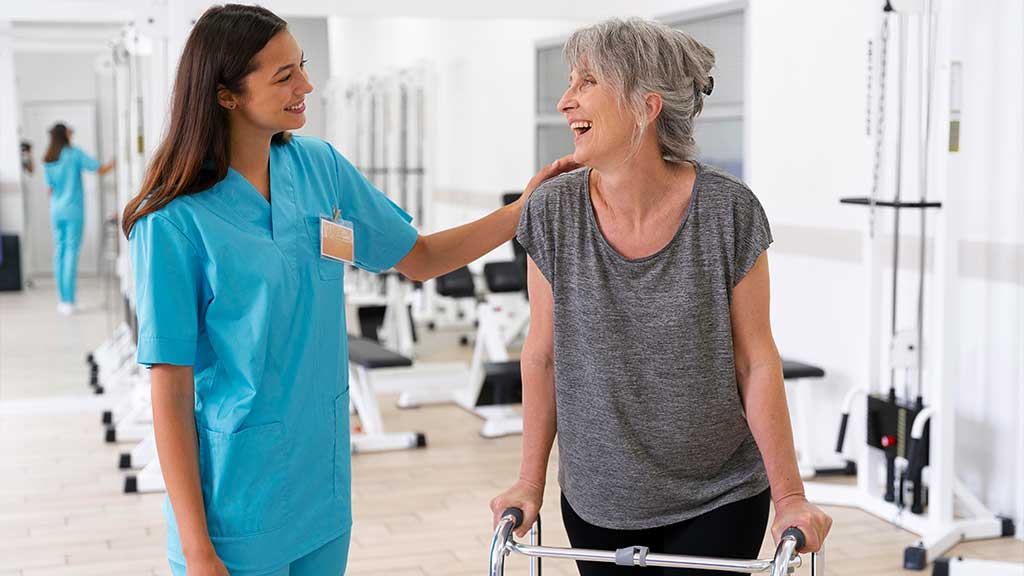Caring for individuals with limited mobility requires not only compassion but also practical skills to ensure their safety and comfort during daily activities. Whether you’re caring for a family member, a friend, or a patient, understanding the proper methods for lifting and transferring is crucial for their safety and your own. Improper lifting can result in muscle strains, back injuries, and even more serious health issues over time. So understanding and implementing correct methods is essential. This comprehensive guide helps you to lift and transfer patients or loved ones safely and effectively.
Lifting Techniques for Caregivers
Lifting techniques for caregivers refer to the methods and strategies used to safely lift and transfer patients or individuals with limited mobility. These techniques are crucial for minimizing the risk of musculoskeletal injuries and ensuring the safety and comfort of both the caregiver and the person being assisted.
Keep Wrists Straight
You might notice that your wrists are bending as you lift your patient due to their weight and the need to keep them from falling. Your joints could suffer because of this. A dorsal wrist impingement is one of the most frequent injuries caregivers sustain when lifting patients with bent wrists because it results from stretching the joint beyond its normal range of motion. Employ your biceps muscles rather than exerting effort with your wrists as you lift your client.
Lift Using Your Legs
The caregiver should lift the patient with their legs, not their arms. Your back shouldn’t generate the force required to raise your client because doing so stresses your muscles and can lead to injuries like strains or herniated discs. Bring the patient up to your body, squat down, and push upward using your heels to raise your legs.
Keep patient Very Close
Caregivers must keep their patients close to their bodies to lift with their legs, maintain a straight back, and prevent twisting at the torso. Your lifting will be more stable, and your leg strength will increase if you keep them near. By balancing some of their weight over your body, you may both remain upright by using this lifting strategy for home caregivers.
Avoid Twisting Your Torso
Home caregivers must maintain a straight back and refrain from twisting when lifting. Back injuries resulting from torso twisting can affect your discs. To get the patient out of bed and onto a wheelchair, do short, deliberate turns oppositely. Avoid twisting your hips.
Go As Slow As You Need To
When raising your patient, there is no need to rush. Going too quickly can cause discomfort, problems, and a higher risk of injury, particularly for elders with shorter reaction times. As a caregiver, giving yourself enough time to adapt to new postures at each stage of the lifting procedure is important.

Use Proper Body Mechanics
Place your feet shoulder-width apart with one foot stamped to aid in balance and turning. As you get closer to your loved one, keep your elbows close to your body. Bend your knees and tighten your abs to stabilize your core. Always lift using your legs, not your back, and turn by stepping lightly or pivoting from your back foot to avoid twisting your waist.
Communicate Properly
Provide clear instructions both before and during the transfer. Ensure you adhere to transferring patient from bed to chair procedure while communicating with the caretaker. Consider the severity of their medical condition and carry out a quick example of the desired activity before training a loved one who suffers from cognitive impairment or other cognitive impairments. To ensure cooperation, decide on the time as well. For instance, you may say, “Count to five and stand on it.”

Request for Support
Encourage any family members who can help you to push themselves up from the ground as they stand. It will lessen your burden and allow the person some control, easing the tension during transfers. Furthermore, it also helps keep their upper bodies strong while preparing for the pushing.
Transfer Techniques for Caregivers to Handle Patient or Client
Transfer techniques for caregivers involve safely moving a patient or client from one position to another, such as from a bed to a chair, or from a wheelchair to a toilet. These techniques are crucial to prevent injuries to both the caregiver and the person being moved. Here’s a detailed guide on transfer techniques:
Slide Board Transfer:
This technique involves using a flat, smooth board to help a patient move from one surface to another, such as from a bed to a wheelchair. Place one end of the slide board under the patient’s buttocks and the other end on the destination surface. The patient can then slide across the board, reducing the need for lifting. This method is especially useful for patients with some upper body strength who can assist in their own transfer. The caregiver should provide support and guidance to ensure the patient moves safely and smoothly.
Pivot Transfer:
The Pivot Transfer technique is a fundamental skill for caregivers aiding individuals with limited mobility. It involves positioning oneself face-to-face with the person needing assistance, ensuring clear communication throughout. The caregiver supports under the knee and behind the back, maintaining balance and control. With coordinated effort, the individual pivots their body, often in a 90- or 180-degree turn, guided by the caregiver’s hands. This method ensures a smooth transition between surfaces like beds and wheelchairs, prioritizing safety and comfort. Caregivers are trained in these techniques to prevent injury, promote independence, and provide efficient care for those they assist.
One-Person Assist:
Caregivers use proper body mechanics, such as maintaining a stable base and utilizing leg muscles instead of the back, to prevent injury while assisting with transfers and ambulation. They often employ assistive devices like transfer belts or mechanical lifts to enhance safety and stability during movements. Clear communication is essential, with caregivers providing instructions and cues to coordinate actions effectively.
Two-Person Assist:
Two-Person Assist in caregiving involves two caregivers collaborating to safely assist individuals with tasks like transfers, ambulation, and positioning. This method ensures tasks requiring more physical support are managed effectively, minimizing risks for both caregivers and recipients of care. Caregivers synchronize their actions to maintain stability and prevent accidents, often designating roles based on the individual’s needs and the environment. Proper Body Mechanics are crucial, with caregivers using techniques like bending at the knees and utilizing leg strength to minimize strain.

Use of Transfer Belts:
Transfer belts are indispensable tools in caregiving, particularly during Two-Person Assist scenarios where individuals require assistance with transfers between surfaces like beds and chairs. These belts are sturdy straps placed around the individual’s waist to provide a secure grip for caregivers.
Bed to Wheelchair Transfer:
A bed to wheelchair transfer is a critical caregiving task that involves safely moving an individual from a bed to a wheelchair. Assess the environment for obstacles and ensure the wheelchair is positioned appropriately next to the bed with brakes locked. Prepare any necessary assistive equipment such as a transfer belt. Communicate clearly with the individual about the transfer process. Ensure they understand and are comfortable with each step.

Chair to Bed Transfer:
Safely move the patient from a chair to a bed using proper lifting and handling techniques to prevent injury. Position the chair and bed close together to minimize the transfer distance. Assess the patient’s ability to assist in the transfer and use aids like transfer belts if necessary. Communicate clearly with the patient throughout the process. Employ correct body mechanics—bend at the knees, keep the back straight—to lift the patient if they cannot assist. Ensure the bed is at an appropriate height relative to the chair. Maintain the patient’s comfort and dignity throughout the transfer.
Mechanical Lift Transfer:
Transfer the patient between locations using a mechanical lift to reduce physical effort and enhance safety. Prepare the lift and position it correctly next to the patient. Apply the sling under the patient as per their mobility needs. Operate the lift smoothly and securely according to manufacturer instructions. Ensure the patient feels secure and comfortable throughout the transfer. Communicate clearly with the patient during the process to maintain reassurance and cooperation. Have a second healthcare worker assist if necessary to ensure stability and safety.
Transfer from Wheelchair to Toilet:
Assist the patient in transferring safely from a wheelchair to a toilet. Lock the wheelchair and position it securely next to the toilet. Assess the patient’s ability to participate in the transfer and provide appropriate support during standing or pivoting. Utilize grab bars or handles if available for added stability. Communicate clearly with the patient to alleviate any concerns and ensure their cooperation. Maintain the patient’s privacy and dignity throughout the process.

Floor to Chair Transfer:
Help the patient move from the floor to a chair using proper techniques to prevent injury. Assess the patient’s condition and any injuries before beginning. Assist the patient to roll onto their side, then support them as they push up onto their hands and knees. Use proper lifting techniques to guide them into a seated position on the chair. Ensure the chair is stable and positioned correctly before the patient sits down. Consider using non-slip mats or additional support if needed for safety. Maintain communication with the patient throughout to ensure their comfort and well-being.
Common Lifting and Transferring Situations
Remembering to employ appropriate forms can help make the procedure safer when adjusting, lifting, or moving an older adult. Nevertheless, various transfers necessitate a variety of methods. The most frequent situations entail aiding someone in standing, sitting up, and sitting down. Here’s how you can ensure the safety of these transfers:
Sitting Up
Getting someone out of bed is a frequent circumstance for transferring. You’ll need to put one arm underneath their back and the other below their legs because this typically indicates they cannot push forward using their hands.
Remember to squat after placing your arms in the appropriate positions. To help your loved one get into a sitting position, maintain a hip-width distance between your feet and gently stagger them. Tilt forward a bit while keeping a straight back.
Standing Up
You can utilize a particular transferring technique to help your loved one stand up if they require assistance getting out of bed, up from the couch, or out of a car. Put their hands on your shoulders and turn to face them.
Put your hands firmly together and wrap your arms around their back while keeping your feet shoulder-width apart and knees slightly bent. Give them a close, almost-hug-like embrace by leaning towards their body. Lift them into a standing position and then shift your weight back.
Sitting Down
When assisting someone to sit in a wheelchair, couch, or chair from a standing posture, begin by having them face the chair from the rear. Their hands should be on the chair’s arms.
You’ll encircle them with your arms and join your hands as you would during a standing-up transfer. As you carefully lower them into a seated position, lean into their body with bowed knees.

Common Lifting and Transferring Mistakes to Avoid
Nobody is perfect, and making errors is a necessary part of learning. Therefore, it is your responsibility to receives the best instruction and professional transfer and lifting training to minimize errors that could result in injuries. Here are a few transfer errors we frequently see, along with solutions.
Inappropriate body mechanics
In most cases, adopting poor body mechanics during transfers is what hurts caregivers the most. Ensure you maintain proper body mechanics for lifting and transferring patients. Furthermore, stay near the person you lift and hold your elbows by your sides. Take tiny steps or pivot to prevent twisting and lift with your legs rather than your back.
Poor communication
Confusion and resistance throughout the transfer can result from failing to address any falling fear (if any), failing to clarify expectations, or delivering confusing directions. To prevent this, we always appeal that caregivers use brief, one-line directions for each transition and wait a short while to give the brain time to comprehend the information.
Rushing
Moving too rapidly or skipping steps can cause an accident or a tumble. Check that the person you love wears the proper footwear, make any required changes to the transfer area, and speak gently. Move freely and slowly when transferring to prevent harm.
Fitness Tips for Caregivers for Safe Lifting and Transferring
Caring for a loved one can be incredibly rewarding, but it also comes with physical demands that can strain your body if not managed correctly. Therefore, it’s essential for caregivers to prioritize their own physical health and safety. Here are some fitness tips specifically tailored for caregivers to ensure safe lifting and transferring:
Regular Exercise
Regular exercise should be a top priority to ensure you’re in good enough physical shape to lift your clients. Exercises that will increase your strength and teach you the correct form for lifting as a caretaker include lunges, deadlifts, push-ups, squats, and step-ups. This transfer training physical therapy can go a long way to provide the needed safety when lifting patients.

Proper Posture
When raising patients, caregivers must maintain perfect posture. When lifting, maintain a natural posture for your back to reduce the risk of injury. Make your daily sitting and standing posture a priority to help you develop a healthy posture. This applies to your caring work and helps with lifting.
Conclusion
Mastering proper lifting and transfer techniques is not just a skill for caregivers; Continuous practice and ongoing education are essential in refining these techniques and adapting them to different caregiving scenarios and individual needs. Caregivers should always prioritize their own safety and well-being, as well as that of the person under their care. By doing so, they contribute to a positive caregiving environment that promotes dignity, comfort, and independence for those they assist.


![Self-Care for Caregivers [Tips from Experts]](https://caregivercourses.net/wp-content/uploads/2024/07/Self-Care-for-Caregivers-Tips-from-Experts-300x169.jpg)


